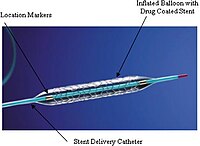
Photo from wikipedia
In the past few decades, the accelerated improvement in technology has allowed the development of new and effective coronary and structural heart disease interventions. There has been inequitable patient access… Click to show full abstract
In the past few decades, the accelerated improvement in technology has allowed the development of new and effective coronary and structural heart disease interventions. There has been inequitable patient access to these advanced therapies and significant disparities have affected patients from low socioeconomic positions. In the US, these disparities mostly affect women, black and hispanic communities who are overrepresented in low socioeconomic. Other adverse social determinants of health influenced by structural racism have also contributed to these disparities. In this article, we review the literature on disparities in access and use of coronary and structural interventions; delineate the possible reasons underlying these disparities; and highlight potential solutions at the government, healthcare system, community and individual levels.
Journal Title: European Cardiology Review
Year Published: 2022
Link to full text (if available)
Share on Social Media: Sign Up to like & get
recommendations!